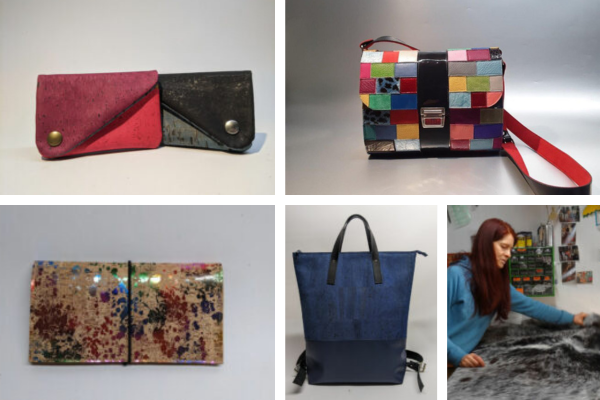
Andrea’s Taschenmanufaktur (Bag manufacturer) already existed for 25 years and produced alternative bags, purses, backpacks, mobile phone pockets and other Arts and Crafts Accessories until she started to move into alternative and sustainable raw materials.
Pineapple leather
Pineapple leather is a tear-resistant, breathable and soft vegan leather made from the fibres of pineapple palm leaves. The pineapple leaves are coated with polyu-rethane (PU) to ensure the durability of the final product. The pineapple leaves are a by-product of an already existing agriculture – and would otherwise end up in the rubbish. In addition, the use of the ana-nas fibres results in a very special look. Pineapple leather can be used very well as an animal leather alternative for shoes, fashion accessories and furniture. Pineapple leather is produced by Ananas Anam under the name Piñatex.
Apple Leather:
Apple leather is made from pomace, the remains of the apple juice industry. The powdered apple residues are mixed with PU and applied to a textile carrier (cotton or polyester). The PU ensures the stability of the leather alternative. Ap-fur leather can be used to make shoes, bags and furniture.
Cork
Cork is a renewable raw material and comes from the cork oak. It is soft, robust, light and sustainable. Regularly peeled cork oaks bind up to four times more carbon dioxide than cork oaks that are never peeled in their life. Until now, we have known cork mainly as a floor covering; cork leather is now used to make jackets, belts and purses. The products are hard-wearing, warming, breathable-active and splash-proof.
- More Info
- Video
- Contact
- Challenge Tackled
– How can we replace leather for bags, purses, key rings and other accessories?
– In the past, these were made from animal leather or, alternatively, from truck tarpaulins.
– With the growing awareness of sustainable living and also the suspicion of health hazards (especially from the truck tarpaulins), it is becoming increasingly important to explore and try alternative base materials to produce bags and accessories in an environmentally friendly way. - Target group, beneficiaries or clients
– Environmentally conscious customers who pay attention to sustainable production
– People who care about animal welfare (see PETA)
– Older ladies who appreciate the fact that the material is very lightweight - Solution
Substitution of leather with alternative materials, e.g.:
– Pineapple leather
– Cork oak bark
– Newly also apple leather
– Workability, precise work - Innovation
– The “Taschenmanufaktur” has been existing for 30 years (and works with leather and tarpaulin)
– For about 4-5 years, the Taschenmanufaktur has been gradually changing its range to alternative leather products.
– They use pineapple leather, cork oak leather and soon also apple leather made from pomace. - Unique Selling Point
– The accessories are increasingly in demand from environmentally conscious customers.
– The new products are increasingly interesting in circular local value chains (apple leather for handbags with a small CO2 footprint). - Impact
– Positive environmental impact
– Health aspect (allergies)
– Innovation
– Contributing to the Circular economy (pineapple residues, decay, soil compaction; Costa Rica - Feasibility/Transferability
– Transfer to prostethics, in products to replace leather
– Cork can be used as residential waterproofing, building materials and furniture
– Clothing made of pineapple leather and cork oak
– Connection to sustainable production projects

